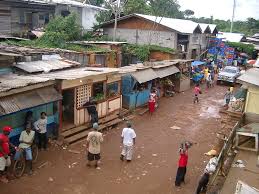 - Although an Amerindian settlement has existed along the Kaituma River for some time, it was only after the discovery of manganese at nearby Matthew's Ridge that Port Kaituma was developed. As Matthew's Ridge was not located on a navigable river, a canal was cut from the Kaituma River and a port constructed, becoming known as Port Kaituma. At the time of the manganese mining, Port Kaituma had three separate areas. The mine managers' house and the guest house were in a large clearing separated by a short road through the forest from the main rail-head and manganese loading facility. A longer road leads in the opposite direction to the area known as 'Bottom Floor' where the workers lived.
- Although an Amerindian settlement has existed along the Kaituma River for some time, it was only after the discovery of manganese at nearby Matthew's Ridge that Port Kaituma was developed. As Matthew's Ridge was not located on a navigable river, a canal was cut from the Kaituma River and a port constructed, becoming known as Port Kaituma. At the time of the manganese mining, Port Kaituma had three separate areas. The mine managers' house and the guest house were in a large clearing separated by a short road through the forest from the main rail-head and manganese loading facility. A longer road leads in the opposite direction to the area known as 'Bottom Floor' where the workers lived.  The manganese was transported from Matthew's Ridge via a 40-mile railway and then shipped from Port Kaituma to Chaguaramas Bay in Trinidad, from where it was distributed for industrial use with a large proportion going to Stavanger in Norway. The project was operated by subsidiaries of Union Carbide.
The manganese was transported from Matthew's Ridge via a 40-mile railway and then shipped from Port Kaituma to Chaguaramas Bay in Trinidad, from where it was distributed for industrial use with a large proportion going to Stavanger in Norway. The project was operated by subsidiaries of Union Carbide.Two Trinidadian oil tankers, the Ambrosio and the Inverrosa, were converted into manganese carriers as part of this project. Originally built around the first world war, they had a displacement of some 3,000 tons each. They made the trip from Port Kaituma to Chaguaramas on a regular four day cycle for much of the 1960s.
Port Kaituma's significance grew further following the proclamation from the then President of Guyana, Forbes Burnham, that Guyana should become more self-sufficient by populating the interior of the country. Matthew's Ridge was highlighted as a potential new capital city and within Port Kaituma a large secondary school was constructed to educate students sent from all over Guyana. During its heyday, the school boasted over 800 students, of which most were housed in two large dormitory buildings.
In the 1970s, Jim Jones' commune of Jonestown was built only seven miles away from Port Kaituma. The first killings of the November 1978 Jonestown massacre occurred in Port Kaituma when Leo Ryan, a U.S. Congressman from California, and others were gunned down while boarding a small Cessna aircraft on the local airstrip. In the aftermath and clean-up operation that ensued, many items from the commune were acquired by the residents of Port Kaituma.
Over the next 25 years, a large foreign-owned logging company came and went, the manganese factory at Matthew's Ridge ceased working and the railway linking Matthew's Ridge and Port Kaituma was closed and in some parts cut up. The school's importance diminshed and fell in to a state of disrepair.
Today, Kaituma serves as the gateway to the nearby jungle where the now predominant industry of small-scale gold mining takes place. The transient nature of many of these porkknockers (gold miners) has led to problems of gun crime, robbery, murder and bribery in the unpoliced hinterlands. This however does not perturb a continual flow of workers through the town, including a recent influx of Brazilians.











No comments:
Post a Comment